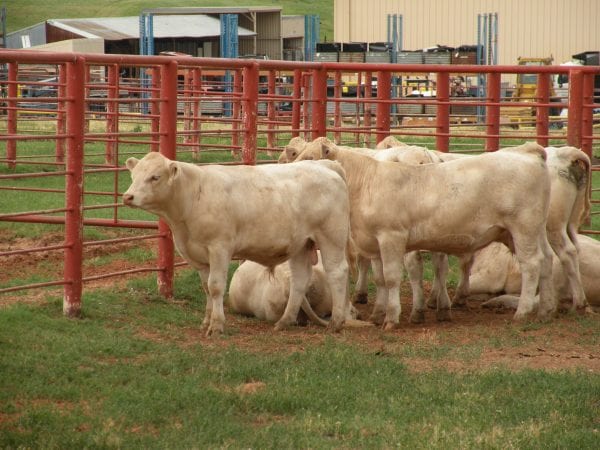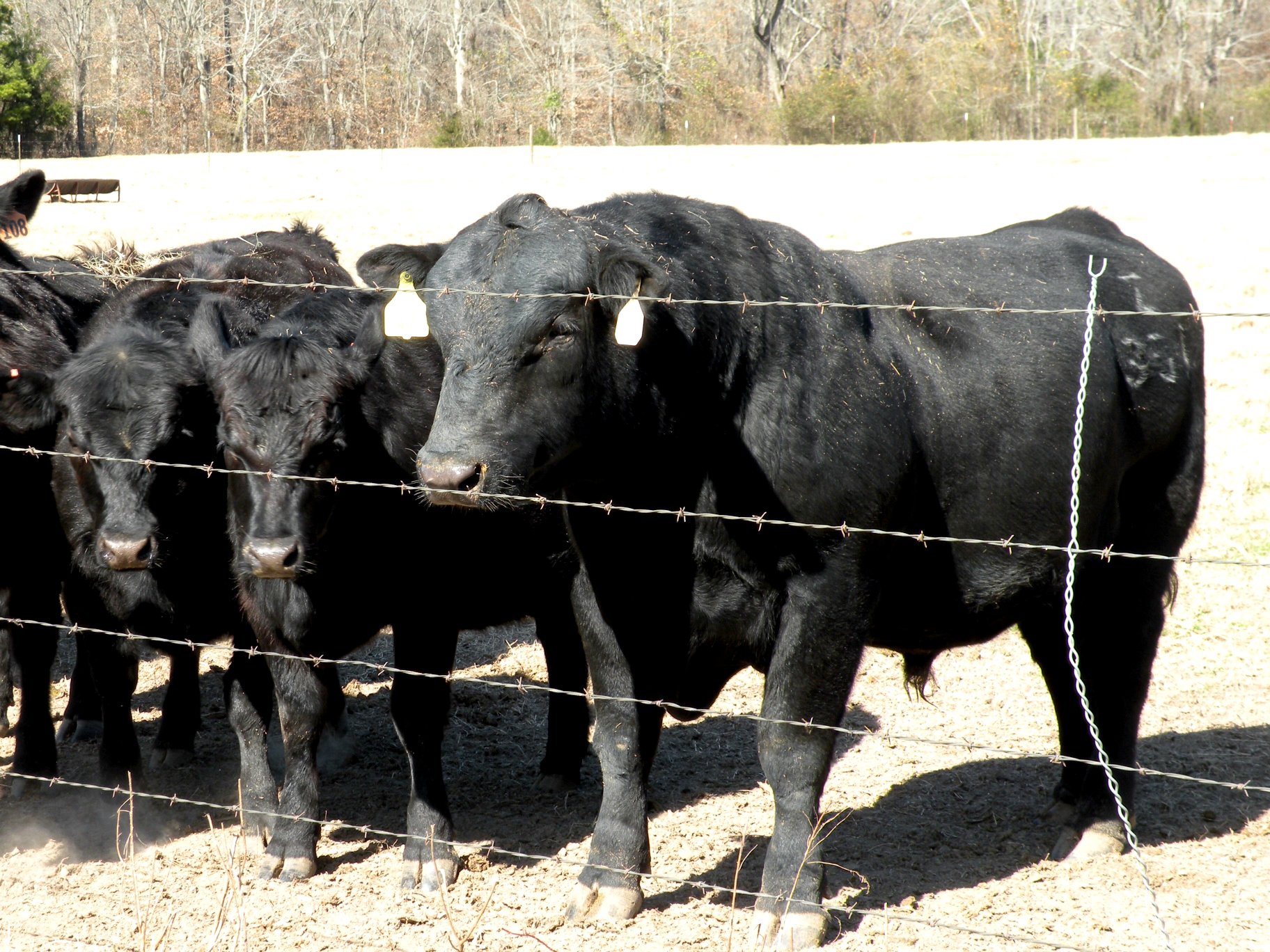Beef

Purchasing a new bull is an investment with long-term impact, both financially and genetically. As a result, bulls should be initially selected on expected progeny differences (EPDs), performance measures, and potentially breed. Final bull selection should include a close scrutiny of overall bull conformation and structural soundness, disposition, and the ability to pass a breeding soundness evaluation.
Unfortunately, many times not much consideration is given to potential diseases a new bull may introduce into the herd upon arrival. The significant financial investment, not to mention the time and effort given to obtaining a new bull, is reason enough to think about instituting appropriate biosecurity measures to maintain herd health when bringing a new bull onto a cattle operation.
Any time a new animal is brought into a herd, potential for disease transmission exists and jeopardizes the health of the entire herd. It is, therefore, important to know what diseases are of greatest concern and what steps can be implemented to minimize the risk of disease.
Following is a brief discussion of several common diseases that can be unknowingly introduced into a herd unless necessary precautions are followed. Consult your veterinarian regarding specific recommendations that will vary depending on animal age, location, and other farm-specific factors.
Trichomoniasis
Trichomoniasis is a bovine venereal disease caused by the protozoan Tritrichomonas foetus and is commonly referred to as “trich.” Bulls can become chronic, asymptomatic carriers of Tritrichomonas foetus with the organism living on a bull’s penis and prepuce. However, when cows are infected during breeding, the result can be early embryonic death, abortion, pyometra (pus-filled uterus detected at pregnancy exam), or infertility. Herd infection with trichomoniasis causes a significant negative impact on the reproductive performance and economic profitability of a cow-calf operation. Bulls only become infected after breeding an infected cow, so purchasing virgin bulls is a good way to avoid this problem. Newly purchased nonvirgin bulls should always be tested for trichomoniasis before the breeding season.
Johne’s Disease
Johne’s disease is a chronic infection caused by the bacteria Mycobacterium avium subspecies paratuberculosis. Clinical signs include gradual weight loss despite a normal appetite, decreased milk production in cows, and manure that gradually becomes more fluid until it progresses into a severe diarrhea. Animals are typically infected with Mycobacterium avium subspecies paratuberculosis as calves, but do not show any clinical signs of Johne’s disease until after a prolonged incubation period (time from infection to clinical disease), often between 2 and 10 years. Such a long incubation period means that many infected animals show no outward clinical signs for many years, but during this time they are infecting new calves every year. No medical treatment exists for Johne’s disease. A killed vaccine for Johne’s disease is available in some states with prior approval by the State Veterinarian. However, the vaccine does have some limitations and side effects. Therefore, it is best to have new bulls tested for Johne’s disease. In addition to diagnostic tests, ask about the Johne’s disease status of a bull’s original herd to help avoid introducing the disease to your herd.
Anaplasmosis
 Anaplasmosis is a disease characterized by progressive anemia and caused by the rickettsial organism Anaplasma marginale. Fever, anorexia, loss of body condition, decreased milk production, abortion, infertility, muscle weakness and depression are commonly seen with anaplasmosis. The disease is present in many parts of the U.S. and causes significant economic losses to the beef and dairy industries. In recent years, veterinarians in some parts of the U.S. are reporting an increase in the number of cases of anaplasmosis, perhaps as a result of increased cattle movement due to drought and other natural disasters. Anaplasma marginale is transmitted from a carrier to susceptible cattle by biting flies and ticks or via contaminated needles, tattoo instruments, dehorning and castration equipment, etc. Treatment of anaplasmosis is often too late once clinical signs are observed. However, animals that survive the initial infection will become lifelong, asymptomatic carriers. Therefore, all new bulls should be tested for anaplasmosis.
Anaplasmosis is a disease characterized by progressive anemia and caused by the rickettsial organism Anaplasma marginale. Fever, anorexia, loss of body condition, decreased milk production, abortion, infertility, muscle weakness and depression are commonly seen with anaplasmosis. The disease is present in many parts of the U.S. and causes significant economic losses to the beef and dairy industries. In recent years, veterinarians in some parts of the U.S. are reporting an increase in the number of cases of anaplasmosis, perhaps as a result of increased cattle movement due to drought and other natural disasters. Anaplasma marginale is transmitted from a carrier to susceptible cattle by biting flies and ticks or via contaminated needles, tattoo instruments, dehorning and castration equipment, etc. Treatment of anaplasmosis is often too late once clinical signs are observed. However, animals that survive the initial infection will become lifelong, asymptomatic carriers. Therefore, all new bulls should be tested for anaplasmosis.
Bovine Viral Diarrhea Virus
Animals persistently infected (PI) with bovine viral diarrhea virus (BVDV) are created when a fetus is exposed to the virus during the first half of pregnancy. During this time, the fetal immune system is not developed enough to respond to a BVDV infection. Instead, the immature fetal immune system recognizes the virus as normal and allows it to replicate freely. Most PI animals die by the time they are two years of age, but some will survive for several years and constantly shed BVDV throughout their life. PI animals will infect the rest of the herd causing fever, diarrhea, respiratory disease, reproductive problems, and much more depending on the age and immune status of each animal infected. Some PI calves are “poor-doers,” while others may look healthy and grow very well, making it impossible to consistently detect PI animals visually. Therefore, it is essential to test a new bull for BVDV-PI status before introducing him to the herd, unless he has previously tested negative by an appropriate BVDV-PI diagnostic test.
Bovine Leukemia
Bovine Leukemia, also known as bovine leukosis, lymphosarcoma or malignant lymphoma, is a viral disease of cattle caused by bovine leukemia virus (BLV). BLV is spread primarily through close physical contact and exchange of contaminated biological materials. The virus is present mostly in white blood cells (immune cells) called lymphocytes that can be found in blood, milk, and tumors. Transmission can occur through blood contaminated needles or equipment (dehorners, castration equipment, tattooing pliers, etc.), and can also occur through biting insects, in utero (4 to 8 percent of BLV cows give birth to calves infected with BLV), and possibly via colostrum or milk from an infected cow. However, infection by contaminated milk is thought to be rare, possibly due to the presence of maternal antibodies in the milk. Lymphosarcoma, the terminal stage of some BLV infections, only occurs in less than 2.5 percent of BLV-infected cattle, and infection with BLV typically occurs several years before the development of lymphosarcoma. All organ systems may be involved resulting in highly variable clinical signs. While most cattle infected with BLV do NOT exhibit clinical signs, BLV infections are lifelong so even asymptomatic animals can serve as viral reservoirs and expose uninfected animals.
Vaccination
Ensuring adequate vaccination of a new bull protects the health of the bull as well as the health of the rest of the herd. At a minimum, bulls should be vaccinated against IBR (infectious bovine rhinotracheitis), BVD (bovine viral diarrhea), PI3 (parainfluenza), BRSV (bovine respiratory syncytial virus), Leptospirosis 5-way, and Vibriosis (Campylobacter fetus). Six to eight weeks prior to the breeding season, bulls should be revaccinated so immunity is high during the breeding season. To ensure maximum product efficacy and safety, properly store and administer vaccines according to label directions, adhere to designated withdrawal times, and follow all other Beef Quality Assurance (BQA) guidelines found at www.bqa.org/ codeguidelines.aspx.
Diagnostic Tests for Infectious Diseases
Diagnostic tests are separated into two types, those designed to detect antibodies against a particular organism (indicating exposure) and those designed to detect the organism itself in an animal’s tissues or body fluids. Regardless of the type of test used, it is very important to remember that every test has advantages and disadvantages and no test is 100 percent accurate. One negative test is no guarantee that an animal does not have an infectious disease, and a positive test result should almost always be confirmed with a follow-up diagnostic test. Work with your veterinarian to evaluate diagnostic testing options and results. Remember, an adequate quarantine period allows time for completion of all initial and follow-up diagnostic tests. Also, given the limited accuracy of some diagnostic test results for individual animals, it is always a good idea to inquire about the health status of a bull’s original herd to help avoid introducing disease into your herd.
Quarantine
Quarantine new bulls for a minimum of 4 to 6 weeks. The quarantine period gives bulls time to recover from any temporary illnesses associated with the stress of the sale or shipping and allows time for completion of all diagnostic tests and a breeding soundness evaluation. The quarantine period also provides time to observe the bull for any other problems before introducing him to the herd. Do not remove bulls from quarantine until all diagnostic test results are complete and reported as negative.
Considering the investment associated with purchasing a new bull, take a little extra time to help protect the health of the bull and the health of your herd. Work with your regional Extension agent and the Alabama Beef Cattle Improvement Association to help find the bull with the best genetics to meet your herd goals, and work with your veterinarian to protect the health of your new bull and the health of your herd.
For more information, please refer to the following:
- ANR-0777, “Bovine Anaplasmosis” www.aces.edu/go/581
- ANR-0968, “Vaccinations for the Beef Cattle Herd” www.aces.edu/go/582
- ANR-1333, “Bovine Trichomoniasis” www.aces.edu/go/583
- ANR-1334, “Bovine Johne’s Disease” www.aces.edu/go/588
- ANR-1367, “Bovine Viral Diarrhea Virus” www.aces.edu/go/589
- ANR-2239, “Bovine Leukosis” www.aces.edu/go/590
Soren P. Rodning, Extension Veterinarian, Associate Professor, Department of Animal Sciences; Lisa Kriese-Anderson, Associate Professor, Department of Animal Sciences; Julie A. Gard, Professor, Department of Clinical Sciences; Michelle F. Elmore, Extension Animal Scientist/Beef Cattle Improvement; Misty A. Edmondson, Associate Professor, Department of Clinical Sciences; and Kim Mullenix, Beef Cattle Systems Extension Specialist, Assistant Professor, Department of Animal Sciences; all with Auburn University
Reviewed May 2022, Maintaining Herd Health When Introducing a New Bull, ANR-2268

